Table Examples¶
from datascience import *
%matplotlib inline
path_data = '../../../assets/data/'
import matplotlib.pyplot as plt
plt.style.use('fivethirtyeight')
import numpy as np
import warnings
warnings.simplefilter(action='ignore', category=np.VisibleDeprecationWarning)
from ipywidgets import interact, interactive, fixed, interact_manual
import ipywidgets as widgets
A pivot from our past: Temperatures in Greenland¶
We spent some time working with our Upernavik climate data.
greenland_climate = Table.read_table('data/climate_upernavik.csv').where('Year', are.above(1876))
greenland_climate = greenland_climate.relabeled('Precipitation (millimeters)', "Precip (mm)")
tidy_greenland = greenland_climate.where('Air temperature (C)', are.not_equal_to(999.99))
tidy_greenland = tidy_greenland.where('Sea level pressure (mbar)', are.not_equal_to(9999.9))
tidy_greenland
| Year | Month | Air temperature (C) | Sea level pressure (mbar) | Precip (mm) |
|---|---|---|---|---|
| 1877 | 1 | -21.1 | 994.9 | 24 |
| 1877 | 2 | -26.5 | 1008.2 | 26 |
| 1877 | 3 | -17.8 | 1013.4 | 84 |
| 1877 | 4 | -12 | 1023.6 | 6 |
| 1877 | 5 | -1.7 | 1019.4 | 9 |
| 1877 | 6 | 1.4 | 1011.8 | 5 |
| 1877 | 7 | 4.6 | 1011.5 | 9 |
| 1877 | 8 | 5.2 | 1019.8 | 29 |
| 1877 | 9 | 3 | 1009 | 51 |
| 1877 | 10 | -2.8 | 1006.2 | 23 |
... (1221 rows omitted)
Group allows us to present average yearly temperates:
temps_by_year = tidy_greenland.group('Year', np.mean)
temps_by_year
| Year | Month mean | Air temperature (C) mean | Sea level pressure (mbar) mean | Precip (mm) mean |
|---|---|---|---|---|
| 1877 | 6.5 | -8.075 | 1010.39 | 23.75 |
| 1878 | 6.5 | -7.43333 | 1011.83 | 29.4167 |
| 1879 | 6.5 | -8.01667 | 1010.03 | 7.08333 |
| 1880 | 6.5 | -8.4 | 1010.75 | 11.5833 |
| 1881 | 6.5 | -7.85833 | 1010.18 | 23.0833 |
| 1882 | 6.5 | -9.99167 | 1011.73 | 8.66667 |
| 1883 | 6.5 | -7.25833 | 1008.32 | 14.8333 |
| 1884 | 6.5 | -10.25 | 1009.11 | 8.41667 |
| 1885 | 6.5 | -8.25833 | 1011.99 | 10.3417 |
| 1886 | 6.5 | -9.99167 | 1010.36 | 9 |
... (97 rows omitted)
We can drop the columns that aren’t meaningful or relevant, before or after the group. (Steve says he usually does it before grouping to always keep the tables as simple as possible…)
temps_by_year = temps_by_year.drop('Month mean')
temps_by_year.plot('Year', 'Air temperature (C) mean')
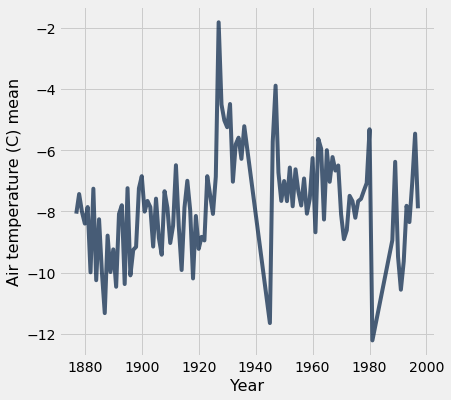
When plotting line graphs, we needed separate columns for each month. A pivot gives us a table with that format.
temps_by_month = tidy_greenland.pivot('Month', 'Year', 'Air temperature (C)', np.mean)
temps_by_month
| Year | 1 | 2 | 3 | 4 | 5 | 6 | 7 | 8 | 9 | 10 | 11 | 12 |
|---|---|---|---|---|---|---|---|---|---|---|---|---|
| 1877 | -21.1 | -26.5 | -17.8 | -12 | -1.7 | 1.4 | 4.6 | 5.2 | 3 | -2.8 | -10 | -19.2 |
| 1878 | -22.9 | -26.9 | -19.6 | -13 | -5.6 | 1.9 | 3.2 | 4.3 | -0.9 | -4 | -2 | -3.7 |
| 1879 | -13.5 | -25.4 | -21.3 | -13 | -2.7 | 0 | 5.2 | 5.8 | -1.1 | -5.5 | -8.2 | -16.5 |
| 1880 | -22.6 | -28.9 | -22.7 | -10.7 | -3.1 | 2.2 | 5.6 | 2.9 | 0.8 | -0.3 | -9.4 | -14.6 |
| 1881 | -13.6 | -19.9 | -26.4 | -12.8 | -3.1 | 1.3 | 5.3 | 4.2 | 0.4 | -2.8 | -9.4 | -17.5 |
| 1882 | -27.6 | -25.6 | -24.9 | -14.8 | -3.2 | 3.1 | 3.3 | 4.1 | 1 | -6.1 | -12.1 | -17.1 |
| 1883 | -19.9 | -21.5 | -12.7 | -12.8 | -1.9 | 3 | 6.2 | 4.4 | 2.2 | -4.1 | -8.9 | -21.1 |
| 1884 | -26.1 | -24.9 | -22.7 | -13.6 | -6.4 | 1.6 | 5.1 | 3.2 | -1.6 | -5.1 | -11.8 | -20.7 |
| 1885 | -15.9 | -18.3 | -23 | -12.8 | -2 | -0.4 | 5.2 | 5.2 | -0.8 | -4.6 | -13.2 | -18.5 |
| 1886 | -24.2 | -25.2 | -23.7 | -18.4 | -2.8 | 1.2 | 5.3 | 4.2 | 0.5 | -6.3 | -11.9 | -18.6 |
... (97 rows omitted)
temps_by_month.select('Year', '2', '9').plot('Year')
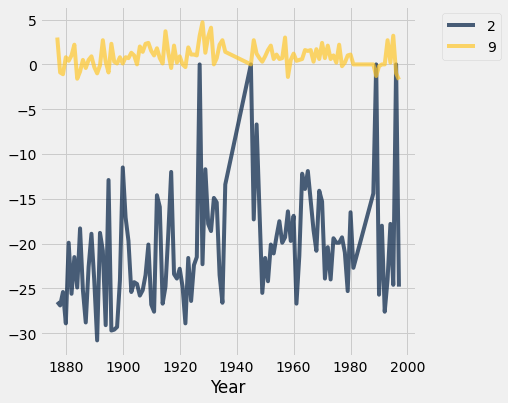
Hopkins Trees¶
hopkins_trees = Table.read_table("data/hopkins-trees.csv")
hopkins_trees = hopkins_trees.drop("genus", "species")
hopkins_trees.show(10)
| plot | common name | count |
|---|---|---|
| p00-1 | Maple, striped | 28 |
| p00-1 | Maple, red | 8 |
| p00-1 | Maple, sugar | 12 |
| p00-1 | Shadbush | 17 |
| p00-1 | Birch, yellow | 7 |
| p00-1 | Birch, paper | 5 |
| p00-1 | Beech, American | 142 |
| p00-1 | Hophornbeam | 7 |
| p00-1 | Cherry, black | 11 |
| p00-1 | Oak, red | 6 |
... (3783 rows omitted)
How many of each species in whole forest? Show top 10 in bar chart.¶
tree_counts = hopkins_trees.drop("plot").group("common name", sum).sort("count sum", descending=True)
tree_counts = tree_counts.relabeled('count sum', 'count')
tree_counts.take(np.arange(0,10)).barh("common name")
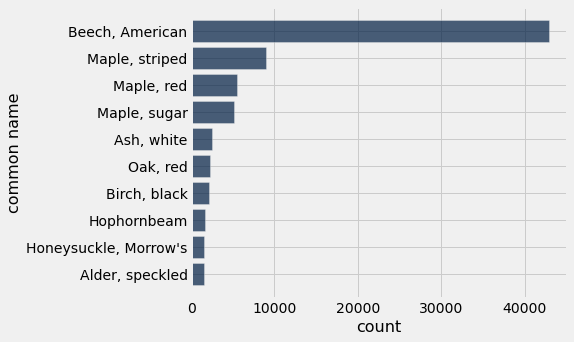
Create a table with counts for each type of maple for each plot.¶
maples = hopkins_trees.where('common name', are.containing('Maple'))
maples.pivot('common name', 'plot', 'count', sum)
| plot | Maple, Norway | Maple, mountain | Maple, red | Maple, striped | Maple, sugar |
|---|---|---|---|---|---|
| p00-1 | 0 | 0 | 8 | 28 | 12 |
| p00-2 | 0 | 0 | 2 | 43 | 14 |
| p0000 | 0 | 0 | 13 | 0 | 4 |
| p0001 | 0 | 3 | 20 | 11 | 0 |
| p0002 | 0 | 0 | 12 | 1 | 0 |
| p0003 | 0 | 0 | 4 | 41 | 1 |
| p0004 | 0 | 0 | 2 | 9 | 3 |
| p0005 | 0 | 0 | 5 | 17 | 0 |
| p0006 | 0 | 0 | 3 | 26 | 14 |
| p0007 | 0 | 0 | 6 | 123 | 67 |
... (410 rows omitted)
Create a table of red maple counts for each plot, in descending order¶
red_maples = hopkins_trees.where("common name", are.equal_to("Maple, red")).sort("count", descending=True)
red_maples
| plot | common name | count |
|---|---|---|
| p0621 | Maple, red | 106 |
| p1236 | Maple, red | 81 |
| p0821 | Maple, red | 76 |
| p1032 | Maple, red | 72 |
| p0629 | Maple, red | 65 |
| p1133 | Maple, red | 64 |
| p1141 | Maple, red | 64 |
| p0630 | Maple, red | 63 |
| p0622 | Maple, red | 62 |
| p0940 | Maple, red | 61 |
... (341 rows omitted)
Make a histogram of how many red maples are in each plot¶
red_maples.hist('count', bins=np.arange(0,100,5))
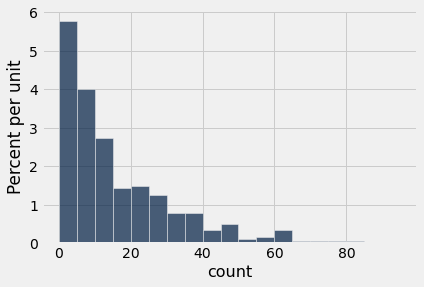
Questions:
What are the units here?
How many plots have fewer than 10 red maples?
Make a histogram of both red maples and red oaks¶
reds = hopkins_trees.where("common name", are.contained_in(make_array("Maple, red", "Oak, red")))
reds.hist('count', group='common name', bins=np.arange(0,100,5))
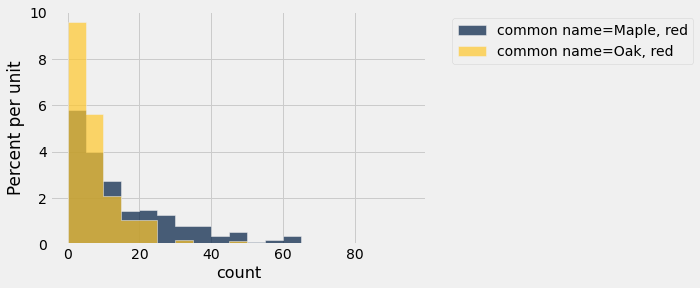
Visualize red maples counts on a map¶
plot_info = Table.read_table("data/hopkins-plots.csv")
plot_info
| plot | latitude | longitude | elevation | slope | aspect |
|---|---|---|---|---|---|
| p00-1 | 42.7472 | -73.2759 | 2389 | 18 | 176 |
| p00-2 | 42.7472 | -73.2772 | 2405 | 22 | 220 |
| p0000 | 42.7472 | -73.2747 | 2343 | 32 | 139 |
| p0001 | 42.7472 | -73.2735 | 2203 | 80 | 275 |
| p0002 | 42.7472 | -73.2723 | 2022 | 75 | 136 |
| p0003 | 42.7472 | -73.271 | 1874 | 60 | 106 |
| p0004 | 42.7472 | -73.2698 | 1726 | 52 | 140 |
| p0005 | 42.7472 | -73.2686 | 1654 | 45 | 150 |
| p0006 | 42.7472 | -73.2673 | 1544 | 55 | 135 |
| p0007 | 42.7472 | -73.2661 | 1445 | 40 | 146 |
... (413 rows omitted)
plot_info = plot_info.select("plot", "latitude", "longitude")
plot_info
| plot | latitude | longitude |
|---|---|---|
| p00-1 | 42.7472 | -73.2759 |
| p00-2 | 42.7472 | -73.2772 |
| p0000 | 42.7472 | -73.2747 |
| p0001 | 42.7472 | -73.2735 |
| p0002 | 42.7472 | -73.2723 |
| p0003 | 42.7472 | -73.271 |
| p0004 | 42.7472 | -73.2698 |
| p0005 | 42.7472 | -73.2686 |
| p0006 | 42.7472 | -73.2673 |
| p0007 | 42.7472 | -73.2661 |
... (413 rows omitted)
maples_with_lat_lon = red_maples.join('plot', plot_info).select('latitude', 'longitude', 'count')
# table must be (lat, lon, colors, areas)
points = maples_with_lat_lon.with_columns("colors", "blue",
"areas", 1.0 * maples_with_lat_lon.column("count"))
Circle.map_table(points).show()
End of lecture¶
This is as far as we got in lecture, but below are more examples you can use for practice.
Generalize to view any species using a function¶
trees_with_lat_lon = hopkins_trees.group(['plot', "common name"], sum).join("plot", plot_info)
trees_with_lat_lon = trees_with_lat_lon.relabeled('count sum', 'count')
trees_with_lat_lon
| plot | common name | count | latitude | longitude |
|---|---|---|---|---|
| p00-1 | Beech, American | 142 | 42.7472 | -73.2759 |
| p00-1 | Birch, paper | 5 | 42.7472 | -73.2759 |
| p00-1 | Birch, yellow | 7 | 42.7472 | -73.2759 |
| p00-1 | Cherry, black | 11 | 42.7472 | -73.2759 |
| p00-1 | Hophornbeam | 7 | 42.7472 | -73.2759 |
| p00-1 | Maple, red | 8 | 42.7472 | -73.2759 |
| p00-1 | Maple, striped | 28 | 42.7472 | -73.2759 |
| p00-1 | Maple, sugar | 12 | 42.7472 | -73.2759 |
| p00-1 | Oak, red | 6 | 42.7472 | -73.2759 |
| p00-1 | Shadbush | 17 | 42.7472 | -73.2759 |
... (3783 rows omitted)
def population_map(tree_name):
counts = trees_with_lat_lon.where("common name", tree_name).select("latitude", "longitude", "count")
points = counts.with_columns("colors", "blue",
"areas", 1.0 * counts.column("count"))
Circle.map_table(points).show()
population_map("Maple, red")
# Note: this visualization requires running the notebook on our servrer.
# We'll see how to do that next week.
all_tree_names = trees_with_lat_lon.sort("common name", distinct=True).column("common name")
_ = widgets.interact(population_map, tree_name=all_tree_names)
Sky Scrapers¶
sky = Table.read_table('data/skyscrapers_v2.csv')
sky.show(5)
| name | material | city | height | completed |
|---|---|---|---|---|
| One World Trade Center | mixed/composite | New York City | 541.3 | 2014 |
| Willis Tower | steel | Chicago | 442.14 | 1974 |
| 432 Park Avenue | concrete | New York City | 425.5 | 2015 |
| Trump International Hotel & Tower | concrete | Chicago | 423.22 | 2009 |
| Empire State Building | steel | New York City | 381 | 1931 |
... (1776 rows omitted)
Here are a bunch of questions you can try to answer about our sky scrapers data. Answers are below, but try them on your own first!
Add an age column that indicates the age of each skyscraper in years.
For each city, what’s the tallest building for each material?
For each city, what’s the height difference between the tallest steel building and the tallest concrete building?
Show a map with heights of tallest in each city.
Add an age column¶
For each city, what’s the tallest building for each material? (Try with both Group and Pivot)¶
For each city, what’s the height difference between the tallest steel building and the tallest concrete building?¶
Show a map with heights of tallest in each city¶
# Here is some lat,lon data for all cities in our skyscraper data
cities = Table().read_table('data/uscities.csv').where('population', are.above(300000))
cities = cities.select('city', 'lat', 'lng')
cities.show(5)
| city | lat | lng |
|---|---|---|
| New York | 40.6943 | -73.9249 |
| Los Angeles | 34.1141 | -118.407 |
| Chicago | 41.8375 | -87.6866 |
| Miami | 25.784 | -80.2101 |
| Dallas | 32.7935 | -96.7667 |
... (141 rows omitted)
Sky Scrapers Answers¶
sky = Table.read_table('data/skyscrapers_v2.csv')
sky.show(5)
| name | material | city | height | completed |
|---|---|---|---|---|
| One World Trade Center | mixed/composite | New York City | 541.3 | 2014 |
| Willis Tower | steel | Chicago | 442.14 | 1974 |
| 432 Park Avenue | concrete | New York City | 425.5 | 2015 |
| Trump International Hotel & Tower | concrete | Chicago | 423.22 | 2009 |
| Empire State Building | steel | New York City | 381 | 1931 |
... (1776 rows omitted)
Add an age column¶
sky = sky.with_column('age', 2022 - sky.column('completed'))
sky.show(3)
| name | material | city | height | completed | age |
|---|---|---|---|---|---|
| One World Trade Center | mixed/composite | New York City | 541.3 | 2014 | 8 |
| Willis Tower | steel | Chicago | 442.14 | 1974 | 48 |
| 432 Park Avenue | concrete | New York City | 425.5 | 2015 | 7 |
... (1778 rows omitted)
For each city, what’s the tallest building for each material?¶
tallest = sky.select('material', 'city', 'height').group(make_array('city', 'material'), max)
tallest.show(5)
| city | material | height max |
|---|---|---|
| Atlanta | concrete | 264.25 |
| Atlanta | mixed/composite | 311.8 |
| Atlanta | steel | 169.47 |
| Austin | concrete | 208.15 |
| Austin | steel | 93.6 |
... (86 rows omitted)
sky_pivot = sky.pivot('material', 'city', 'height', max)
sky_pivot.show()
| city | concrete | mixed/composite | steel |
|---|---|---|---|
| Atlanta | 264.25 | 311.8 | 169.47 |
| Austin | 208.15 | 0 | 93.6 |
| Baltimore | 161.24 | 0 | 155.15 |
| Boston | 121.92 | 139 | 240.79 |
| Charlotte | 265.48 | 239.7 | 179.23 |
| Chicago | 423.22 | 306.94 | 442.14 |
| Cincinnati | 125 | 202.69 | 175 |
| Cleveland | 125 | 288.65 | 215.8 |
| Columbus | 79.25 | 0 | 169.3 |
| Dallas | 176.48 | 280.72 | 270.06 |
| Denver | 194.75 | 212.75 | 217.63 |
| Detroit | 221.49 | 0 | 173.26 |
| Honolulu | 129.8 | 0 | 130.75 |
| Houston | 217.63 | 305.41 | 302.37 |
| Indianapolis | 128.17 | 0 | 213.67 |
| Jersey City | 162.16 | 0 | 238.05 |
| Kansas City | 189.89 | 0 | 146.61 |
| Las Vegas | 350.22 | 195.68 | 164.6 |
| Los Angeles | 145.7 | 118.26 | 310.29 |
| Miami | 240.41 | 232.8 | 147.52 |
| Miami Beach | 170.39 | 0 | 0 |
| Milwaukee | 136 | 0 | 183.19 |
| Minneapolis | 203.58 | 241.38 | 144.64 |
| New York City | 425.5 | 541.3 | 381 |
| Philadelphia | 157.89 | 296.73 | 288.04 |
| Phoenix | 124.1 | 114 | 147.22 |
| Pittsburgh | 89.3 | 172 | 256.34 |
| Portland | 155.15 | 127.4 | 166.42 |
| Sacramento | 106.98 | 115.82 | 122.6 |
| Salt Lake City | 114.91 | 0 | 128.63 |
| San Diego | 151.49 | 144.78 | 152.4 |
| San Francisco | 196.6 | 260 | 237.44 |
| Seattle | 138.69 | 284.38 | 235.31 |
| St. Louis | 100.66 | 180.75 | 147.6 |
| Sunny Isles Beach | 196 | 0 | 0 |
For each city, what’s the height difference between the tallest steel building and the tallest concrete building?¶
sky_diff = sky_pivot.with_column(
'difference',
abs(sky_pivot.column('steel') - sky_pivot.column('concrete'))
)
sky_diff
| city | concrete | mixed/composite | steel | difference |
|---|---|---|---|---|
| Atlanta | 264.25 | 311.8 | 169.47 | 94.78 |
| Austin | 208.15 | 0 | 93.6 | 114.55 |
| Baltimore | 161.24 | 0 | 155.15 | 6.09001 |
| Boston | 121.92 | 139 | 240.79 | 118.87 |
| Charlotte | 265.48 | 239.7 | 179.23 | 86.25 |
| Chicago | 423.22 | 306.94 | 442.14 | 18.92 |
| Cincinnati | 125 | 202.69 | 175 | 50 |
| Cleveland | 125 | 288.65 | 215.8 | 90.8 |
| Columbus | 79.25 | 0 | 169.3 | 90.05 |
| Dallas | 176.48 | 280.72 | 270.06 | 93.58 |
... (25 rows omitted)
Show a map with heights of tallest in each city¶
cities = Table().read_table('data/uscities.csv').where('population', are.above(300000))
cities = cities.select('city', 'lat', 'lng')
cities.show(5)
| city | lat | lng |
|---|---|---|
| New York | 40.6943 | -73.9249 |
| Los Angeles | 34.1141 | -118.407 |
| Chicago | 41.8375 | -87.6866 |
| Miami | 25.784 | -80.2101 |
| Dallas | 32.7935 | -96.7667 |
... (141 rows omitted)
tallest = sky.select('material', 'city', 'height').group('city', max)
tallest = tallest.join('city', cities).select('lat', 'lng', 'city', 'height max')
points = tallest.with_columns('colors', 'blue',
'areas', tallest.column("height max"))
Circle.map_table(points).show()
